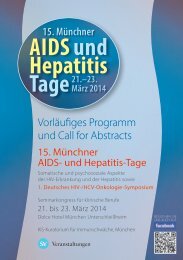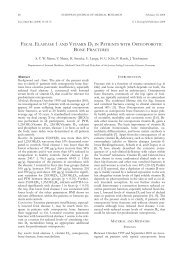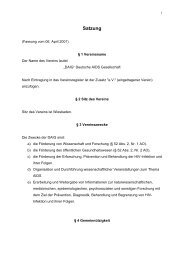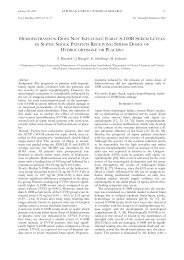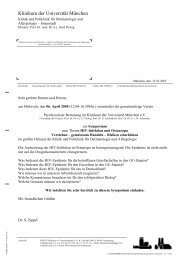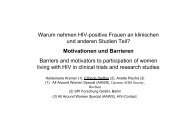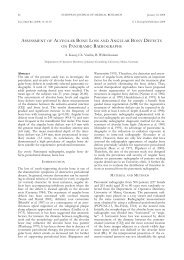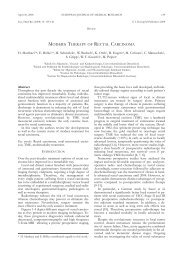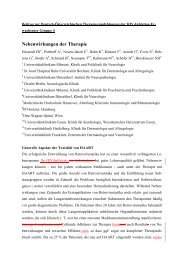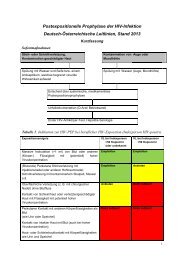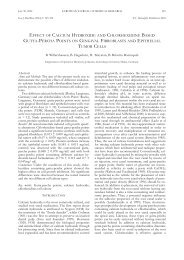European Journal of Medical Research - Deutsche AIDS ...
European Journal of Medical Research - Deutsche AIDS ...
European Journal of Medical Research - Deutsche AIDS ...
Create successful ePaper yourself
Turn your PDF publications into a flip-book with our unique Google optimized e-Paper software.
48 EUROPEAN JOURNAL OF MEDICAL RESEARCH<br />
June 27, 2007<br />
Methodik: Auswertung der Gesundheitsstatistik, Experteninterviews<br />
mit Ärzten und Vertretern von Pharmaunternehmen,<br />
Entwicklung von Modellpatienten, Berechung von Behandlungskosten<br />
auf Basis hypothetischer Lebensläufe, diskontiert<br />
auf den Barwert.<br />
Ergebnisse: HIV bzw. <strong>AIDS</strong> sind aus ökonomischer Sicht<br />
sehr komplexe Erkrankungen. Um diesen Komplexitätsgrad<br />
zu reduzieren, wurden mit Experten "Modellpatienten" entwickelt.<br />
Nach Berechnung von Arzneimittelkosten, Ambulanzbesuchen,<br />
Spitalsaufenthalten und eventueller Pensionierung<br />
(letztere beide nur für <strong>AIDS</strong>-Patienten) ergab sich folgender<br />
ökonomischer Kostenbefund: Eine HIV-Infektion in Österreich<br />
verursacht (auf den Barwert diskontiert) Kosten von<br />
446.960 Euro bis 563.582 Euro (je nach Lebensalter,<br />
Geschlecht und Compliance), eine <strong>AIDS</strong>-Erkrankung einer<br />
45jährigen Frau belastet das Gesundheitsbudget mit 557.760<br />
Euro, die eines gleich alten Mannes mit 633.284 Euro (auf<br />
Grund unterschiedlicher durchschnittlicher Pensionsansprüche).<br />
Werden Compliance erhöhende Maßnahmen<br />
(z.B. der Einsatz von Adherence Nurses) durchgeführt, reduzieren<br />
sich damit die Gesundheitsausgaben pro Patient<br />
stark. Durch den vermehrten Besuch der Ambulanz sowie<br />
durch höheren Testungsaufwand erhöhen sich bei non-compliant<br />
Patienten am Beispiel einer 30jährigen HIV-positiven<br />
Frau die diskontierten lebenslangen Kosten der Behandlung<br />
um rund 63.000 Euro.<br />
Schlussfolgerungen: Für HIV/<strong>AIDS</strong>-Erkrankungen kann es<br />
gesundheitsökonomisch nur folgende sinnvolle Vorgehensweise<br />
geben:<br />
1. Prävention und damit Nicht-Ansteckung<br />
2. Wenn eine Ansteckung erfolgt ist: frühzeitige Therapie und<br />
ein den Behandlungsrichtlinien des Arztes folgendes Patientenverhalten<br />
3. Jede Verbesserung des Patientenverhaltens ist zu unterstützen<br />
und damit besonders der Einsatz von speziell geschulten<br />
Pflegekräften („Adherence Nurses“).<br />
A.58 (Poster)<br />
DAGN-AD improve project part II: National<br />
health economic cohort analysis (K3A)<br />
Goetzenich A. 1 , Hanh<strong>of</strong>f N. 1 , Knechten H. 2 , Wasem J. 3 ,<br />
Neumann A. 3<br />
1 DAGNÄ e.V., Aachen, Germany, 2 PZB, Aachen, Germany,<br />
3 Universität Duisburg-Essen, Lehrstuhl für Medizin-<br />
Management, Essen, Germany<br />
Background: With ever increasing rates <strong>of</strong> HIV-infection in<br />
Germany, the impact <strong>of</strong> this condition is not only significant<br />
medically but also health economically. Recent nation-wide<br />
data on the costs <strong>of</strong> HIV/<strong>AIDS</strong> are lacking. Further, data on<br />
HIV-infection in Germany and its current management outside<br />
the clinical trials setting are needed.<br />
Objectives: The objectives <strong>of</strong> this analysis are:<br />
1) to gather data on the health economics <strong>of</strong> HIV-infection in<br />
Germany,<br />
2) to sub-analyse these data according to stages <strong>of</strong> the condition,<br />
3) to gather data on clinical parameters and antiretroviral<br />
treatment, including reasons for discontinuing or changing<br />
therapy.<br />
Methods: The DAGN-AD Improve national health economic<br />
cohort analysis (K3A) is a prospective, multi-centre evalua-<br />
tion. Continuous health economical and clinical data pertaining<br />
to HIV-infection is gathered for each patient for 18<br />
months. The health economical data include both direct (incurred<br />
through all HIV-related diagnostic and therapeutic procedures)<br />
and indirect costs (incurred through e.g. absence<br />
from employment due to illness, etc.). Clinical data include<br />
information on routine laboratory parameters (CD4 cell count,<br />
HIV-RNA), on <strong>AIDS</strong>-defining illnesses, on HIV-associated<br />
illnesses and co-infections and on antiretroviral therapy use.<br />
The latter also includes reasons for any treatment discontinuation<br />
or change. Data are obtained via health economic questionnaires<br />
and physician clinical documentation. The questionnaires<br />
are employed at every patient visit.<br />
Results: Calculations based on a statistical power <strong>of</strong> 90%<br />
with a 5% confidence interval indicated that at least 528 cases<br />
need to be recruited. Nation-wide, 33 HIV-specialty and ambulatory<br />
care centres are participating in this evaluation and<br />
have recruited 668 patients. These are representative <strong>of</strong> the<br />
geographical distribution <strong>of</strong> all HIV-infected individuals in<br />
Germany according to epidemiological data published by the<br />
RKI. The evaluation is ongoing. A limitation to this study is<br />
that intangible costs (a monetary value assigned to pain, decreased<br />
quality <strong>of</strong> life, etc.) are not gathered.<br />
A.59 (Poster)<br />
Analysis <strong>of</strong> German costs <strong>of</strong> full virological<br />
suppression for treatment experienced, HIV<br />
infected patients in the POWER trials<br />
Stoll M. 1 , Hill A. 2<br />
1 Medizinische Hochschule Hannover, Zentrum Innere<br />
Medizin, Abt. Klinische Immunologie, Hannover, Germany,<br />
2 University <strong>of</strong> Liverpool, Pharmacology <strong>Research</strong><br />
Laboratories, Liverpool, United Kingdom<br />
Background: The aim <strong>of</strong> antiretroviral treatment is long-term<br />
suppression <strong>of</strong> HIV RNA below 50 HIV RNA copies/mL. The<br />
POWER 1 and 2 trials evaluated new protease inhibitor treatment<br />
– darunavir/ritonavir (DRV/r) 600/100 mg BID versus<br />
Control PI (CPI), in treatment experienced patients, where<br />
complex and expensive drug combinations are typically required.<br />
Methods: Office based German 2007 costs (including tax)<br />
were used. Average costs <strong>of</strong> antiretroviral treatment were calculated<br />
from the percentage use <strong>of</strong> NRTIs, PIs and T-20 in the<br />
DRV/r and Control PI arms <strong>of</strong> the POWER 1 and 2 trials. Rates<br />
<strong>of</strong> HIV RNA suppression



